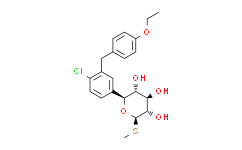| Cas No.: | 1018899-04-1 |
| Chemical Name: | Sotagliflozin |
| Synonyms: | (2S,3R,4R,5S,6R)-2-[4-chloro-3-[(4-ethoxyphenyl)methyl]phenyl]-6-methylsulfanyloxane-3,4,5-triol;LP 802034;LX4211;Sotagliflozin (LX4211);(2S,3R,4R,5S,6R)-2-(4-chloro-3-(4-ethoxybenzyl)phenyl)-6-(methylthio)tetrahydro-2H-pyran-3,4,5-triol;(2S,3R,4R,5S,6R)-2-[4-chloro-3-(4-ethoxy-benzyl)-phenyl]-6-methylsulfanyl-tetrahydro-pyran-3,4,5-triol;CS-1069;LP-802034;Sotagliflozin;UNII-6B4ZBS263Y;LX-4211;SOTA-009;(5S)-Methyl 5-C-[4-chloro-3-[(4-ethoxyphenyl)methyl]phenyl]-1-thio-beta-L-xylopyranoside;LX421;EOS-61381;LX4211 - L10525;LX-4211 (sotagliflozin);Zabofloxacin Hydrochloride;6B4ZBS263Y;beta-l-Xylopyranoside, methyl 5-C-(4-chloro-3-((4-ethoxyphenyl)methyl)phenyl)-1-thio-, (5S)-;b-L-Xylopyranoside, methyl 5-C-[4-chloro-3-[(4-ethoxyphenyl)methyl]phenyl]-1-thio-, (5S)-;b-L-Xylopyranoside, methyl 5-C-[4-chloro-3-[(4-ethoxyphenyl)methyl]phenyl]-1-thio-, (5S)-;Sotaglifloz |
| SMILES: | ClC1C([H])=C([H])C(=C([H])C=1C([H])([H])C1C([H])=C([H])C(=C([H])C=1[H])OC([H])([H])C([H])([H])[H])[C@@]1([H])[C@@]([H])([C@]([H])([C@@]([H])([C@]([H])(O1)SC([H])([H])[H])O[H])O[H])O[H] |
| Formula: | C21H25ClO5S |
| M.Wt: | 424.9382 |
| Sotrage: | 2 years -20°C Powder, 2 weeks 4°C in DMSO, 6 months -80°C in DMSO |
| Description: | LX-4211 is a potent dual SGLT2/1 inhibitor; Antidiabetic agents.IC50 value:Target: SGLT1/2LX4211 enhanced urinary glucose excretion by inhibiting SGLT2-mediated renal glucose reabsorption; markedly and significantly improved multiple measures of glycemic control, including fasting plasma glucose, oral glucose tolerance, and HbA(1c); and significantly lowered serum triglycerides. LX4211 also mediated trends for lower weight, lower blood pressure, and higher glucagon-like peptide-1 levels. In a follow-up single-dose study in 12 patients with T2DM, LX4211 (300 mg) significantly increased glucagon-like peptide-1 and peptide YY levels relative to pretreatment values, probably by delaying SGLT1-mediated intestinal glucose absorption [1]. LX4211-treated mice and SGLT1-/- mice also had increased GLP-1 AUC values, decreased glucose-dependent insulinotropic polypeptide (GIP) AUC values, and decreased blood glucose excursions during the 6 hours after a challenge with oral glucose alone [2]. |






















